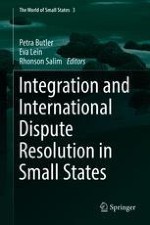2018 | OriginalPaper | Buchkapitel
6. Intellectual Property Consequences of Commercial Relations with Small States: A View from the Pacific
verfasst von : Sue Farran
Erschienen in: Integration and International Dispute Resolution in Small States
Aktivieren Sie unsere intelligente Suche, um passende Fachinhalte oder Patente zu finden.
Wählen Sie Textabschnitte aus um mit Künstlicher Intelligenz passenden Patente zu finden. powered by
Markieren Sie Textabschnitte, um KI-gestützt weitere passende Inhalte zu finden. powered by
